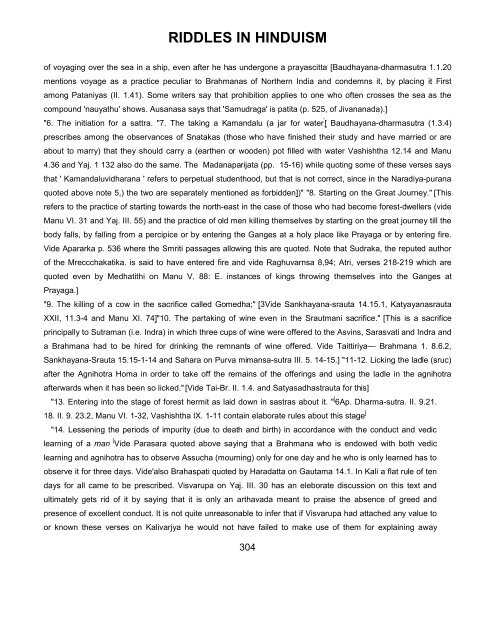Create successful ePaper yourself
Turn your PDF publications into a flip-book with our unique Google optimized e-Paper software.
RIDDLES IN HINDUISM<br />
of voyag<strong>in</strong>g over the sea <strong>in</strong> a ship, even after he has undergone a prayascitta . [Baudhayana-dharmasutra 1.1.20<br />
mentions voyage as a practice peculiar to Brahmanas of Northern India and condemns it, by plac<strong>in</strong>g it First<br />
among Pataniyas (II. 1.41). Some writers say that prohibition applies to one who often crosses the sea as the<br />
compound 'nauyathu' shows. Ausanasa says that 'Samudraga' is patita (p. 525, of Jivananada).]<br />
"6. The <strong>in</strong>itiation for a sattra. "7. The tak<strong>in</strong>g a Kamandalu (a jar for water ' [ Baudhayana-dharmasutra (1.3.4)<br />
prescribes among the observances of Snatakas (those who have f<strong>in</strong>ished their study and have married or are<br />
about to marry) that they should carry a (earthen or wooden) pot filled with water Vashishtha 12.14 and Manu<br />
4.36 and Yaj. 1 132 also do the same. The Madanaparijata (pp. 15-16) while quot<strong>in</strong>g some of these verses says<br />
that ' Kamandaluvidharana ' refers to perpetual studenthood, but that is not correct, s<strong>in</strong>ce <strong>in</strong> the Naradiya-purana<br />
quoted above note 5,) the two are separately mentioned as forbidden])" "8. Start<strong>in</strong>g on the Great Journey." [This<br />
refers to the practice of start<strong>in</strong>g towards the north-east <strong>in</strong> the case of those who had become forest-dwellers (vide<br />
Manu VI. 31 and Yaj. III. 55) and the practice of old men kill<strong>in</strong>g themselves by start<strong>in</strong>g on the great journey till the<br />
body falls, by fall<strong>in</strong>g from a percipice or by enter<strong>in</strong>g the Ganges at a holy place like Prayaga or by enter<strong>in</strong>g fire.<br />
Vide Apararka p. 536 where the Smriti passages allow<strong>in</strong>g this are quoted. Note that Sudraka, the reputed author<br />
of the Mreccchakatika. is said to have entered fire and vide Raghuvarnsa 8,94; Atri, verses 218-219 which are<br />
quoted even by Medhatithi on Manu V. 88: E. <strong>in</strong>stances of k<strong>in</strong>gs throw<strong>in</strong>g themselves <strong>in</strong>to the Ganges at<br />
Prayaga.]<br />
"9. The kill<strong>in</strong>g of a cow <strong>in</strong> the sacrifice called Gomedha;" [3Vide Sankhayana-srauta 14.15.1, Katyayanasrauta<br />
XXII, 11.3-4 and Manu XI. 74]"10. The partak<strong>in</strong>g of w<strong>in</strong>e even <strong>in</strong> the Srautmani sacrifice." [This is a sacrifice<br />
pr<strong>in</strong>cipally to Sutraman (i.e. Indra) <strong>in</strong> which three cups of w<strong>in</strong>e were offered to the Asv<strong>in</strong>s, Sarasvati and Indra and<br />
a Brahmana had to be hired for dr<strong>in</strong>k<strong>in</strong>g the remnants of w<strong>in</strong>e offered. Vide Taittiriya— Brahmana 1. 8.6.2,<br />
Sankhayana-Srauta 15.15-1-14 and Sahara on Purva mimansa-sutra III. 5. 14-15.] "11-12. Lick<strong>in</strong>g the ladle (sruc)<br />
after the Agnihotra Homa <strong>in</strong> order to take off the rema<strong>in</strong>s of the offer<strong>in</strong>gs and us<strong>in</strong>g the ladle <strong>in</strong> the agnihotra<br />
afterwards when it has been so licked." [Vide Tai-Br. II. 1.4. and Satyasadhastrauta for this]<br />
"13. Enter<strong>in</strong>g <strong>in</strong>to the stage of forest hermit as laid down <strong>in</strong> sastras about it. " [ 6Ap. Dharma-sutra. II. 9.21.<br />
18. II. 9. 23.2, Manu VI. 1-32, Vashishtha IX. 1-11 conta<strong>in</strong> elaborate rules about this stage ]<br />
"14. Lessen<strong>in</strong>g the periods of impurity (due to death and birth) <strong>in</strong> accordance with the conduct and vedic<br />
learn<strong>in</strong>g of a man [ Vide Parasara quoted above say<strong>in</strong>g that a Brahmana who is endowed with both vedic<br />
learn<strong>in</strong>g and agnihotra has to observe Assucha (mourn<strong>in</strong>g) only for one day and he who is only learned has to<br />
observe it for three days. Vide'also Brahaspati quoted by Haradatta on Gautama 14.1. In Kali a flat rule of ten<br />
days for all came to be prescribed. Visvarupa on Yaj. III. 30 has an eleborate discussion on this text and<br />
ultimately gets rid of it by say<strong>in</strong>g that it is only an arthavada meant to praise the absence of greed and<br />
presence of excellent conduct. It is not quite unreasonable to <strong>in</strong>fer that if Visvarupa had attached any value to<br />
or known these verses on Kalivarjya he would not have failed to make use of them for expla<strong>in</strong><strong>in</strong>g away<br />
304


















